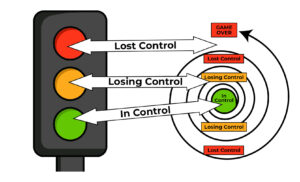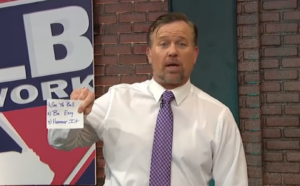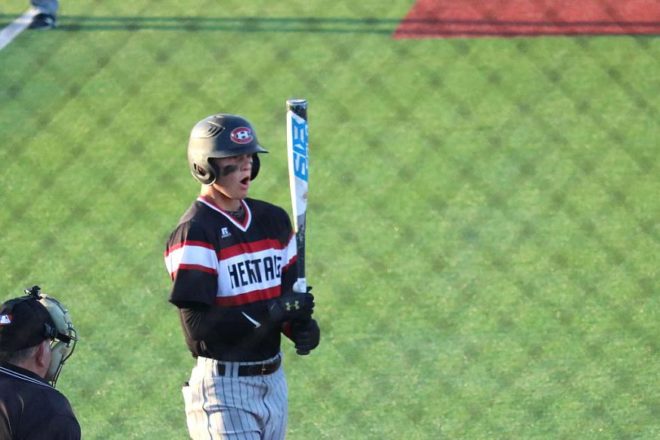What is awareness?
Put simply, awareness is your ability to recognize:
- what’s happening around you
- what’s happening to you
- what’s happening inside you
You might be thinking to yourself…
How can this help me or the athletes that I coach?
How can this help my child perform better?
It’s kinda like walking up to one of those giant digital maps at the airport to help find a restaurant, coffee, or the closest restroom.
Imagine how difficult it would be to use that map without the “You’re Here” icon—the map would essentially be useless.
The same goes for performance—in order to get where you want to go, it’s critical to have the awareness of where you currently are in order to develop a [training] plan to get there.
The lack of self-awareness is one of the biggest challenges I see in the development of coaches and athletes today, especially the younger age groups.
These clients have yet to develop the skill of clearly understanding and evaluating where they’re at in this moment and the steps it takes to get where they want to go.
Mental performance is no different.
“I must be in control of myself before I can control my performance”
There is good news—this is a skill can be trained, just like the physical skills you focus on when you think of practice.
I’ll show you what to do and how to do it after a quick story.
Lesson from the Octagon
I had the privilege to coach Georges St-Pierre (GSP) during his pre-fight camp leading up to UFC 74 against Josh Koscheck—his first fight after suffering, at that time, the largest upset in UFC history to Matt Serra.
Georges was a 11-1 favorite going into that fight against Serra—having previously earned the title by avenging his loss to Matt Hughes.
In his first fight against Matt Hughes Georges told me that, “I couldn’t look him in the eye at the stare down because he was my idol. I gave too much credit to Matt Hughes and I lost the fight before it started.”
That’s when it all clicked for me!
Putting too much thought into your opponent is a waste of time and energy flows where your attention (awareness) goes. Your attention should be on YOU because that’s the only thing within your control.
The exact opposite of that is true as well.
Thinking too little about your opponent and going into the competition underprepared can hurt you too—which GSP was guilty of going into his first bought with Serra.
In the rematch against Matt Serra, however, Georges prepared the right way and dominated because his increased self-awareness.
Key Points:
- Awareness comes before growth—It’s the precursor to all growth. If you’re aware of it, you can go to work on it and have a better chance of controlling, influencing it as it relates to performance.
- What you’re not aware of is going to control you.
- You must be aware and in control of where your energy is going.
- You must be aware that you can have fear and still choose confidence.
Confidence and fear can live together. In facet if you’re going to compete, you’ll have to learn how to manage both—it just comes down to how you process it.
If you’re unaware of that, you’re going to go searching for a feeling, “Why do I not feel confident?,” instead of searching for a focus, “What is it that I need to do here now?”
Georges had to learn to be in control of himself before he could control his performance.
He had to focus his awareness on his body language, focus, and self-talk aka his “BFS”.
Then he was able to step into the octagon and compete at an elite level, no matter what opponent he was facing.
In the video above, I share an interview with Georges from inside his hotel room after beating Josh Koscheck at UFC 74.
Remember: awareness allows you to modify your behavior and give yourself the best chance for success through preparation and performance.
Here are four strategies that I use with all of my clients to help them build the awareness they need to win [and so can you].
Developing the Awareness to Win
Strategy #1: Know the Difference Between Your Best and Worst Performances
Start by grabbing a notebook or blank sheet of paper and draw a line down the center.
Write BEST at the top of one column, WORST at the top of the other.
List the characteristics of your performances at each level.
Begin looking for tendencies and make the conscious choice to do more of what you do when you’re at your best and less of what you do when underperforming.
Decisions determine destiny. It is not nature or nurture that determines who you become, it’s your decisions.
DECIDE to act in alignment with who you are when you’re performing at your best.
DECIDE to let go of the actions taken at your worst.
No matter what happens during competition, you are responsible and in control of your BFS.
Strategy #2: Develop Awareness By Focusing On Your “BFS”
What is “BFS” stand for?
Body Language
Focus
Self-Talk
Here’s an exercise you can use to draw awareness to your “BFS”—keep in mind this is unique to you—there is no right or wrong way to do this as long as you are using honest self-evaluation.
Take a blank sheet of paper—on the left side of your page write down:
- Body Language
- Focus
- Self-Talk
You are going to make two columns: When I’m In Control of Myself (green lights) and When I Start to Lose It (yellow and red lights)
It’s an activity that’s going to look similar to what we did earlier in Strategy #1 (above).
Invest some time completing this exercise and give yourself honest self-evaluation.
By having the awareness and ability to label…
When I’m in green lights I’m (fill in the blank).
When I’m in yellow or red lights I’m (fill in the blank).
…you can make the conscious decision to get back into being in control of yourself (green lights) by going through your release routine.
3 Steps to “Flush It”:
- Physical Action: take a deep breathe
- Focal Point: focus your vision on a specific spot (the smaller and more specific the better)
- Verbal Trigger: that mantra or word that you say to yourself to get you back to being in green
You’d do that go through your release routine, right? Following your three steps to be able to flush it, that physical action, that deep breath on a focal point, and that verbal trigger, that key, that mantra that you say to yourself to get you back to being in green lights, which we’ll talk more about in the future.
Strategy #3: Develop Awareness By Understanding Your Signal Lights
Sticking with our concept of signal lights as a key to teach awareness and that you’ve got to be in control of yourself before you can control your performance—let’s talk about the three Ps of green lights and the three Ps of red/yellow lights.
3 Ps for Green:
When you’re in green lights and you’re performing your best, it’s present, process, and pounding.
I’m in the present moment right here, right now.
I’m focused on my process in my routine, and I’m pounding the zone (pitcher) or target (golfer).
3 Ps for Yellow and Red:
Then when I get into red or yellow lights and I get outside of that present, process, and pounding.
I get into what we call prayer, primal, and perfect.
It’s a concept that comes out of the book Heads Up Baseball by Dr. Ken Ravizza and Tom Hansen—to help coaches, athletes, and parents illustrate what it’s like to be in red lights when an athlete is loosing control.
What is your tendency when you struggle?
Is your default to go into prayer mode? Just hoping to get the job done.
Or are you’re more primal—gritting your teeth and opting for the caveman approach by doing it harder and faster.
Or do you get into perfect mode, where you think you got to make the perfect shot, you got to throw the perfect pass as a quarterback, you got to have perfect technique instead of just finding a way to win?
Start to use this language as a way to recognize when you’re getting out of control.
Strategy #4: Develop Awareness By Focusing On Your Self-Talk
Self-talk is what to say when you talk to yourself.
You talk to yourself daily
The question is —are you saying something that’s productive to help you in performance or are you saying what’s counterproductive in that red/yellow light voice?
Make sure you are talking to yourself intentionally—not listening to whatever language pops up in your head.
So the strategy that we use here is called a mantra. A mantra is something that you say to yourself when things get hard to keep you in the moment.
Some examples might include:
- “Right here, right now.”
- “Execute this pitch.”
- “Fairways. See the target, hit the target.”
- “The time is now and the place is here.”
- “Work fast, pound down.”
In a training context it might be:
- “One rep at a time, right here, right now”
“This play, align, assign, execute”
Find something that works for you!
I encourage my clients to write down three self-talk statements that they can come back to when they need it.
Index Card Reminder
My friend Sean Casey used to carry an index card in his back pocket.
A 10-year MLB player would take an index card and write down three mental keys for him, essentially three short, simple mantras.
He’d write down, “See the ball. Be easy. Hammer it.” And he would have that with him as a way to bring awareness back to the present moment if he noticed that he started getting out of control.
We all need reminders—even the pros!
Start using these strategies to build up your awareness muscle. You must put it into practice in order to develop mastery.
Do you want to learn more strategies around confidence, overcoming obstacles, how to conquer fear of failure, and learn how to consistently perform your best?
Then fill out the form below to enroll in my FREE 3-Day mini course—one specific for athletes and the other for coaches.






